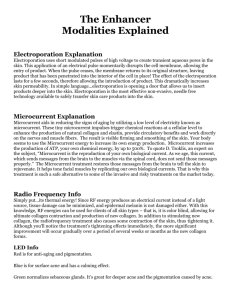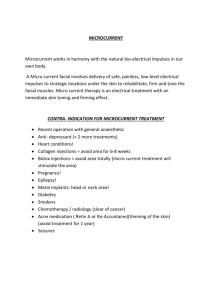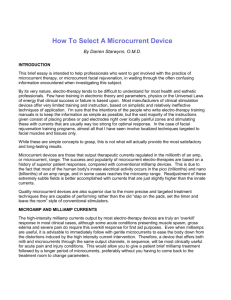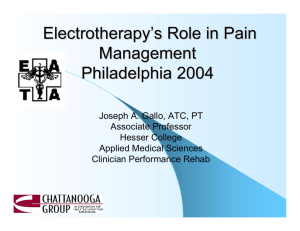Publication overview .
advertisement
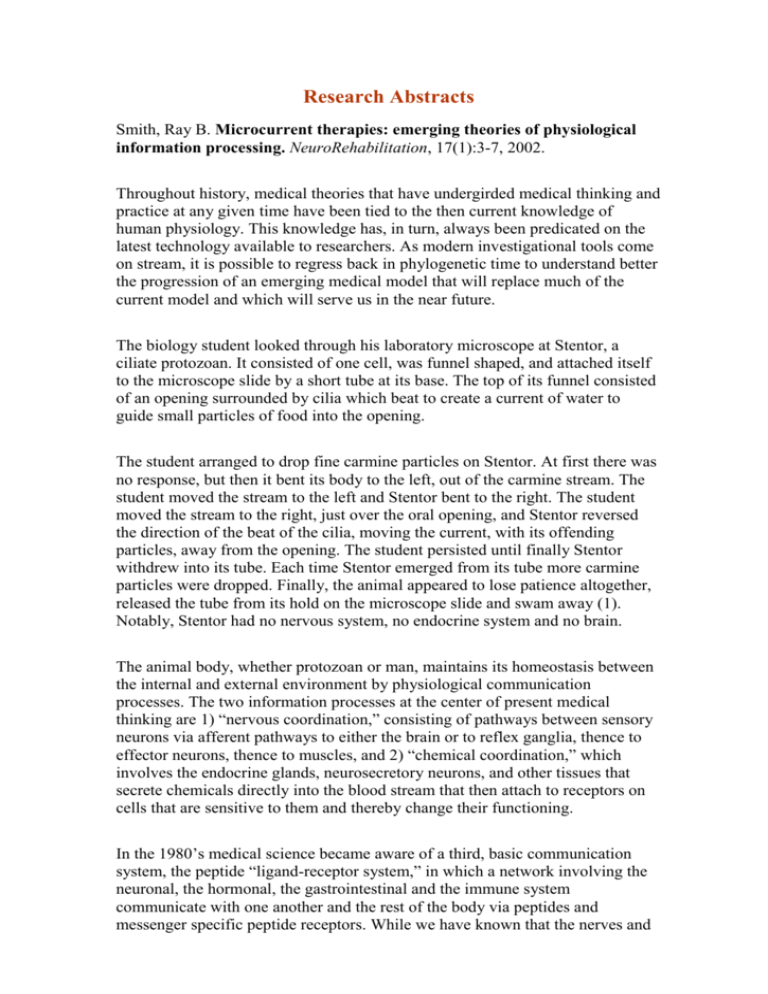
Research Abstracts Smith, Ray B. Microcurrent therapies: emerging theories of physiological information processing. NeuroRehabilitation, 17(1):3-7, 2002. Throughout history, medical theories that have undergirded medical thinking and practice at any given time have been tied to the then current knowledge of human physiology. This knowledge has, in turn, always been predicated on the latest technology available to researchers. As modern investigational tools come on stream, it is possible to regress back in phylogenetic time to understand better the progression of an emerging medical model that will replace much of the current model and which will serve us in the near future. The biology student looked through his laboratory microscope at Stentor, a ciliate protozoan. It consisted of one cell, was funnel shaped, and attached itself to the microscope slide by a short tube at its base. The top of its funnel consisted of an opening surrounded by cilia which beat to create a current of water to guide small particles of food into the opening. The student arranged to drop fine carmine particles on Stentor. At first there was no response, but then it bent its body to the left, out of the carmine stream. The student moved the stream to the left and Stentor bent to the right. The student moved the stream to the right, just over the oral opening, and Stentor reversed the direction of the beat of the cilia, moving the current, with its offending particles, away from the opening. The student persisted until finally Stentor withdrew into its tube. Each time Stentor emerged from its tube more carmine particles were dropped. Finally, the animal appeared to lose patience altogether, released the tube from its hold on the microscope slide and swam away (1). Notably, Stentor had no nervous system, no endocrine system and no brain. The animal body, whether protozoan or man, maintains its homeostasis between the internal and external environment by physiological communication processes. The two information processes at the center of present medical thinking are 1) “nervous coordination,” consisting of pathways between sensory neurons via afferent pathways to either the brain or to reflex ganglia, thence to effector neurons, thence to muscles, and 2) “chemical coordination,” which involves the endocrine glands, neurosecretory neurons, and other tissues that secrete chemicals directly into the blood stream that then attach to receptors on cells that are sensitive to them and thereby change their functioning. In the 1980’s medical science became aware of a third, basic communication system, the peptide “ligand-receptor system,” in which a network involving the neuronal, the hormonal, the gastrointestinal and the immune system communicate with one another and the rest of the body via peptides and messenger specific peptide receptors. While we have known that the nerves and endocrine glands manufacture messenger chemicals, and that the gastrointestinal membranes comprised the largest endocrine “gland” in the human body, we did not know that immune cells also make, store, and secrete neuropeptides which serve to communicate and interact with the other communication systems to control the tissue integrity of the body. Like the others, the peptides manufactured by the cells of the immune system also can regulate mood or emotion.(2) Pert states, “Let me summarize the basic idea I have been developing. The three classically separated areas of neuroscience, endocrinology, and immunology, with their various organs – the brain; the glands; and the spleen, bone marrow, and lymph nodes – are actually joined to each other in a multidirectional network of communication, linked by information carriers known as neuropeptides.” (3) Even though the discovery of the third major communication system in the body began with Pert’s discovery of the opiate receptor in October, 1972, and research on it has continued through the 1980’s, and 1990’s, knowledge of that system has still not entered mainstream medicine. If we can rely on past timing it may have another 20 years to wait. Actually, the ligand-receptor system was almost certainly at work in controlling the behavior of Stentor in the illustration given above. One celled organisms were very busy maintaining their own internal homeostasis, signaling each other, chasing down and devouring (and digesting) food, avoiding danger, and duplicating themselves either sexually or asexually. Buchsbaum and Milne state, “for our purpose it is enough to keep in mind that a protozoan is not comparable to a single cell of a man but to his whole body. …it is at least as remarkable that protozoans are able to carry on all the complex processes of life within a single microscopic globule as that many-celled animals can do the same thing through the combined activities of vast numbers of walled-off and specialized units.”(4) The ligand-receptor peptides that protozoans used are almost certainly the same or nearly identical to the ones that man now produces. Hickman notes, “In the long and important chemical evolution that preceded the advent of living organisms, the groundwork for the basic plan of physiologic mechanisms was laid down. …by its very nature, the number and types of chemicals were tied to the basic process in which carbon, under the influence of radiation energy were synthesized into compounds that progressed to protein molecules, the formation of nucleoproteins and high-energy phosphate bonds, the electron transfer system of metabolism, the selective diffusion of organic molecules, the enzymatic action at all steps of the metabolic process, and other functional aspects, all of which evolved during the preliminary biochemical evolutionary process…. “During the so-called organic evolution that gave rise to the great diversity of life as we now know it, there have been very few biochemicals added to organic life.” (5) His point is that due to the nature of the process, animals were forced to share the limited compounds that could be made. Hickman wrote that in 1967, but it took the advent of new technology in the 1970’s to prove him right. It is now known that the protozoa produce most, if not all of the same peptides that cells in our immune system currently manufacture and secrete, or as Bentley put it, “It is now generally accepted that vertebrate hormones and their receptors may have evolved from identifiable counterparts among the invertebrates.”(6) In the process of evolution, then, while one celled animals carried on intracellular and extracellular communication by simple diffusion processes, as animals became larger it was necessary to develop specialized cells to manufacture and carry peptides to distant parts of the organism to cells that were specializing to provide movement for the organism. These were nerves and muscle tissue. Later, groups of cells were set aside to specialize in the manufacture and excretion of specific chemical substances that could be carried throughout the organism by the newly acquired circulatory system. These we now know as endocrine cells, or glands, when grouped. These systems are still evolving. Neurosecretary cells are neurons that still manufacture peptides and secrete them directly into the blood stream. They are sometimes thought of as an evolutionary link in the chain that unites the neural and endocrine systems. They represent the final pathway for conveying neural impulses to the endocrine system.(7) Among the hormones they make are epinephrine, vasopressin, oxytocin, and the hypophysiotropic hormones. (8) At this point in our evolutionary history, in addition to the neurosecretory nerves, many cells that manufacture and secrete endocrine peptides are not all collected nicely into specific glands, but are still somewhat scattered about, such as the Islets of Langerhans scattered about in the pancreas, or the walls of the gastrointestinal system which comprises the largest “endocrine gland” in our body at present, with numerous types of hormone-containing cells dotted along the epithelial lining of the gastrointestinal tract.(9) Toward the last of the 20th century it was found that areas of the cardiac atrial muscle manufacture and secrete endocrine peptides.(10) The body’s immune system could be considered the most diverse “endocrine gland” of all were it not for the fact that it has not been set aside to make a specific hormone, but appears to still be manufacturing a wide spectrum of the peptides that have been carried over from the protozoa in the course of evolutionary time. Not only have receptors been found on immune cells “for virtually every peptide… we (have) identified in the brain,” (11), but it is now known that all of the white blood cells manufacture all of the peptides that the other parts of the system make: neurotransmitters such as seratonin, dopamine, norepinephrine, endorphins, and so forth.(12) And the brain is far from being the center of a center for hardwired reflexes, running the body in a more or less mechanical, reactive fashion by electrical stimulation across the synapse as we previously saw it. In fact it is speculated that no more than 2 to 4% of the peptides leaving the pre synaptic membrane actually act on a post synaptic membrane in its immediate vicinity, the remainder traveling across intracellular space as far as 4 inches to their receptor cells.(13) Another recent author refers to the brain, not as a hardwired machine in which electrical stimulation across the synapse runs the body in a more or less mechanical, reactive fashion, with little room for flexibility, change, or intelligence, but as an oversized neurosecretory gland in which all kinds of chemicals which it manufactures and which bathe it have their effects. “Indeed, hormones are so intricately involved in neural events that some researchers no longer picture the brain as a machine or computer but consider it instead to be a gland. …It is becoming increasingly clear that our control center is not only a place, but a process involving the interrelationship between the brain, our hormones, our biochemistry, and the environment.” (14) While this third physiological information system is waiting its turn for entrance into the medical curriculum, another, perhaps more disquieting finding is standing in the wings: In the human, at least, one’s thoughts can directly influence the contents and functioning of the ligand-receptor system, so that negative thoughts can not only increase cortisol levels and decrease the production of immune cells, positive thoughts can increase one’s level of endorphins, dopamine, sex hormones, and so on, and actually increase the number of immune cells circulating in the blood system.(15,16) The final addition to the reigning confusion is going to be the connection between energy fields, either internally generated or externally applied, as they interact with this new physiological communication paradigm. While the energy emitted or transferred through crystals may not readily enter the medical curriculum any time soon (17), medical educators can no longer ignore studies showing the healing power of concentrated intention (sometimes called prayer) (18), or therapeutic touch (called the laying on of hands by some practitioners). (19) A fast expanding school of psychotherapy analyses changes in the body’s neuromuscular energy system to discover and subsequently treat psychological problems by adding energy into the system. They theorize as follows, “The thought field, like any field, exists as a pattern or form with certain degrees of stability or homeostasis. The goal of (psychotherapy) is to profoundly alter the integrity of such pathognomonic energy fields at sufficiently relevant levels, so that a return to the previous forms becomes less probable or even impossible.”(20) The medical use of magnets is relatively new to the scene, but is probably here to stay. (21) Acupuncture is also apparently a recent but permanent fixture in American medicine. It deals with an energy system which is conceptualized to flow throughout our body, both at the subsurface and deeper levels. The unimpeded flow of this energy is thought to have everything to do with our health and wellbeing. (22) Finally, physicists seek new measuring techniques with which to measure “subtle” energy in the Fourier transform relationship between information patterns in the direct space domain and the frequency (wave number) domain. They think in terms of dual four-space frames imbedded in a nine-space frame, which is, in turn, imbedded in a ten-space frame which is imbedded in an eleven space frame or energy dimension. If they are out there, they are thought to be almost certainly a real, active force in our body’s physiological communication system. (23) For now we know that if small amounts of microcurrent is applied across the brain in what we in the U.S. call cranial electrotherapy stimulation (CES), neurotransmitters that are out of homeostasis due to some prior, reasonably prolonged stress reaction, whether it be psychological or physical such as drug abuse, will come back into homeostasis and any concomitant anxiety, depression or sleep problems will subside. (24, 25) We know that if microcurrent stimulation is applied to broken bones that have refused to heal, they will begin to mend. (26) We know that when microcurrent is applied into and nearby small cancerous growths in the lung, they will disintegrate and die. (27) We know that if we put microcurrent into the wrist over the artery pulse points in patients who are in pain, the brain’s EEG pattern will normalize and the pain will be significantly reduced or disappear altogether. (28) We know that just a few minutes of microcurrent applied near arteries and veins on the feet will reduce physiological stress and pain. (29) As noted above, earlier animal research showed that microcurrent stimulation to the head normalized relationships between neurotransmitters in the brain, while other animal research found that microcurrent applied to the skin increased the presence of ATP in the stimulated areas by 500%, increased the inflow of amino acids to the area as well as protein synthesis. (30) But we had no way to account for the normalization of the EEG, the reduction of pain or the generalized relaxation response that result when areas over major arteries are stimulated. Now we can be fairly certain that microcurrent, applied this way, is stimulating numerous peptide responses from immune cells flowing beneath the electrodes. Or as Bauer theorizes, an electromagnetic field may act in the same way as a hormone upon the cell membrane, causing a “perturbation” or repositioning of the molecular plasma membrane of cells. This in turn may influence membrane enzyme systems by favorably altering stereoscopic configurations of molecules, essentially holding membrane molecules in the correct stereoscopic configuration or orientation for chemical reactions to take place. (31) We don’t know why it prevents or cures migraine headaches, but it does (32), why CES applied across the head can significantly reduce fibromyalgia pain throughout the body (33), or why it reduces arthritis pain or hip leg and foot pain in diabetic neuropathy. (34) We don’t know why patients with reflex systemic dystrophy and patients with multiple sclerosis often respond to it with a reduction in symptoms. (35) We have yet to learn why phobic patients and those with post traumatic stress dysfunction, or those with obsessive-compulsive disorder, or those with bipolar disorder are often apparently completely cured with only one hour a day of stimulation for three weeks. But both research and clinical experience show that they do. (36) To summarize, if we are to understand the body’s communication systems, we have to look farther back in our animal history than we have done so far. We also have to look forward into the newly burgeoning studies of energy, both those that are generated within us and those that impinge upon us from without. But we can remain confident, while we continue those investigations, that medically applied microcurrent energy has a basic, interactive, regulatory role in the body’s communication systems, whose vast potential is yet to be completely investigated. References 1. Ramsay JA. (1968) Physiological approach to the lower animals, 2nd Edition. Cambridge: Cambridge University Press, 144. 2. Pert CB. (1997) Molecules of emotion. New York:Touchstone, 164, 189. 3. Pert CB ibid., 184. 4. Buchsbaum R, Milne LJ.(1962). The lower animals; living invertebrates of the world. Garden City, New York: Doubleday, 17 5. Hickman CP (1967). Biology of the invertebrates. St. Louis: C.V. Mosby, 20. 6. Bentley PF (1998). Comparative vertebrate endocrinology, 3rd Edition. Cambridge:Cambridge University Press, 4. 7. Carpenter MB (1976). Human neuroanatomy. Baltimore: Williams & Wilkins, 91-92. 8. Bentley PF, op.cit., 3. 9. Vigna SR (1986). Gastrointestinal tract. In Vertebrate Endocrinology: Fundamentals and Biomedical Implications. Vol. 1, Morphological Considerations (Pang PKT, Shreibman MP (Eds). Orlando, FL: Academic Press, 261-278. 10. Bentley PF, op.cit, 13. 11. Pert CB. Op.cit., 163. 12. Pert CB. Ibid., 182-3. 13. Pert CB. Ibid, 130. 14. Crenshaw TL. (1996) The alchemy of love and lust.New York:Simon & Schuster. Xx-xxi 15. Tiller WA. (1997) Science and human transformation; subtle energies, intentionality and consciousness. Walnut Creek, CA:Pavior Publishing, 222. 16. Crenshaw TL. Op cit. xxvi, 109. 17. Gerber R. (2000) Vibrational medicine for the 21st century; the complete guide to energy healing and spiritual transformation. New York City:HarperCollins, 246-247. 18. Dossey L. (1993) Healing words; the power of prayer and the practice of medicine. New York City: HarperCollins. 19. Macrae J. (1987) Therapeutic touch: a practical guide. New York:Alfred A. Knopf. 20. Gallo FP (2000) Energy diagnostic and treatment methods. New York:W.W.Norton, 11. 21. Null, G. (1998) Healing with magnets. New York:Carroll & Graf Publishers. 22. Helms J. (1995) Acupuncture energetics; a clinical approach for physicians. Berkely, CA: Medical Acupuncture Publishers. 23. Tiller WA. Op cit., 56. 24. Pozos RS, Strack LE, White RK, Richardson AW. (1971) Electrosleep versus electroconvulsive therapy. In Reynolds Dv, Sjoberg AE (Eds.) Neuroelectric Research. Chrales Thomas:Springfield, 23:221-225. 25. Bianco F. (1994) The efficacy of cranial electrotherapy stimulation (CES) for the relief of anxiety and depression among polysubstance abusers in chemical dependency treatment. Ph.D. dissertation, The University of Tulsa. 26. Becker RO, Selden G. (1985) The body electric; electromagnetism and the foundation of life. New York: William Morrow, 175-180. 27. Nordenstrom, BEW. (1983) Biologically closed electric circuits; clinical, experimental and theoretical evidence for an additional circulatory system. Stockholm, Sweden: Nordic Medical Publications, 269-317. 28. Heffernan M. (1997) The effect of variable microcurrents on EEG spectrum and pain control. Canadian J Clin Med 4(20):4-11. 29. Heffernan M. (1994) Personal communication. 30. Chang N, VanHoff H, BockxE, et al. (1982) The effect of electric currents on ATP generation, protein synthesis, and membrane transport in rat skin. Clin Orthoped, 171:264-72. 31. Bauer W. (1983) Neuroelectric medicine. J Bioelectricity, 2(2&3):159-80. 32. England RR. (1976) Treatment of migraine headache utilizing cerebral electrostimulation. Masters Thesis, North Texas State University, Denton, Texas. 33. Lictbroun AS, Raicer M-MC, Smith RB.(2001) The treatment of fibromyalgia with cranial electrotherapy stimulation. J Clin Rheumatology, 7(2):72-78. 34. Smith RB (2001) Is microcurrent stimulation effective in pain management? An additional perspective. Am. J. Pain Management, 11(2):62-66. 35. Alpher EJ, Kirsch DL (1998) A patient with traumatic brain injury and full body reflex sympathetic dystrophy treated with cranial electrotherapy stimulation. Am J Pain Management 8(4):124-8. 36. Smith RB, Shiromoto FN. (1992) The use of cranial electrotherapy stimulation to block fear perception in phobic patients. J Cur Therapeutic Research 51(2):249-53.
